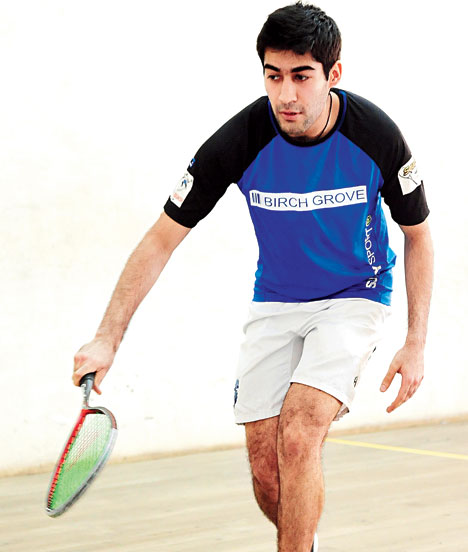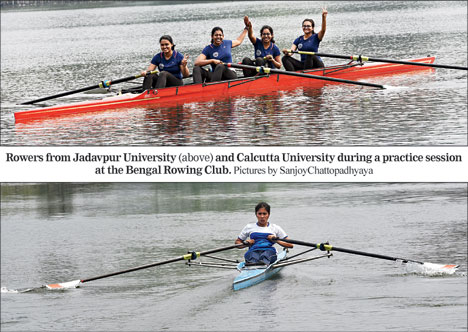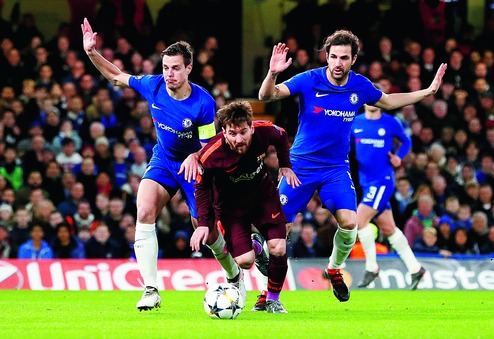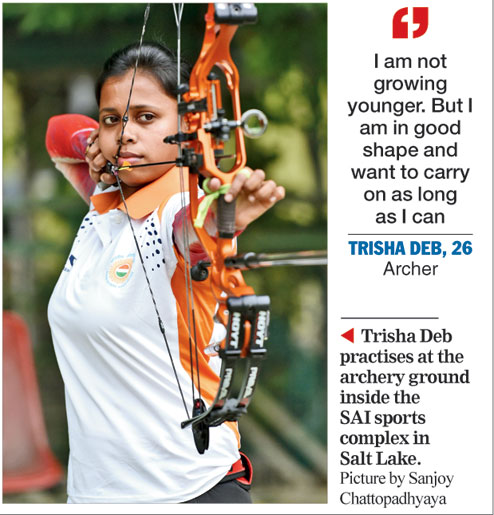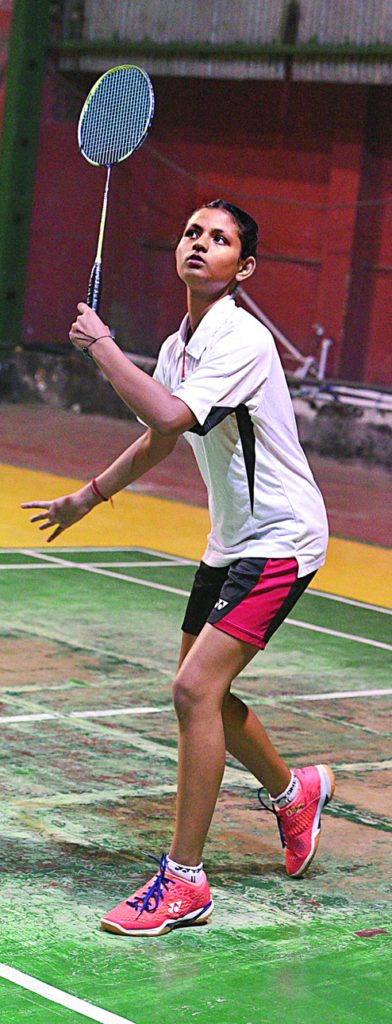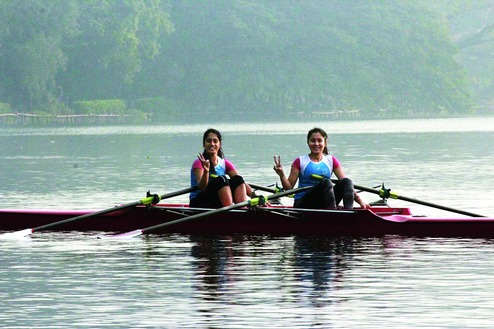Bengal has talented sportswomen aplenty but why is they do not have their deserved place on the sporting map of India? Moumita Chaudhuri goes looking for answers
.



FOULED: (From top) Archer Dola Banerjee (left) with Bombayla Devi Laishram and Deepika Kumari after winning gold in the 2010 Commonwealth Games; a file picture of current football coach Sujata Kar; Kar’s ward Rojina Khatun
A 17-year-old was returning from a neighbourhood function with her mother when they stopped at a grocery shop. The small television set was telecasting a weightlifting competition. Mother and daughter watched a young woman struggling to lift a bar with weights on either side. As other bystanders watched in awe and cheered, the mother wondered what the big deal was. After all, her daughter would routinely lift heavy sacks of grain by way of running errands for their neighbours in Habibpur village of Bengal’s Nadia district. “Some of the elderly people would ask me to lug a sack or two to the storeroom on the second or third floor for a rupee or two. Sometimes they would shoo me away after the work was done,” says Rakhi Halder, weightlifter from Bengal.
Egged on by her mother, Rakhi signed up for formal training at the local club – a single-storey structure with a big hall, some equipment and a tin roof. She says, “They had a couple of weights and the only ones who ever practised were men.” When the trainer asked her to lift a 40-kilo weight, she did so effortlessly. And that is how, within five days of signing up as a weightlifter, when she could barely tell a “clean and jerk” from a “snatch”, Rakhi participated in a state-level competition and won it too. A year later, in 2012, she won the Oceania Commonwealth Junior Championship in Australia.
Since then, Rakhi has gone on to break Karnam Malleswari’s record in the 33rd Women’s Senior National Weightlifting Championships in Mangalore, Karnataka. She had trained to participate in the Commonwealth Games in Gold Coast, Australia, that begin this week, but owing to some procedural issues was not selected. She now has her hopes pinned on the 2018 Asian Games scheduled for September in Jakarta.
But the larger dream she nurtures is to train at least six students before she retires from the sport. As of now, she has one student who has won a gold medal at the 2017 state-level meet. Rakhi and her husband – he is also her coach – Naveen Kumar, are currently employed as Group C staff with the Eastern Railways. They dip into their earnings for Rakhi’s training as well as that of her student. She says impassionedly, “I want weightlifting to stay alive in Bengal.”
Bengal’s sportswomen have always done her proud, be it in swimming, table tennis, football, archery, volleyball or cricket. Bula Chowdhury crossed the English Channel in 1989, Dola Banerjee has a world record in archery, Sujata Kar played in the Indian football team, Poulomi Ghatak is creating new records in table tennis, Mehuli Ghosh just won two bronzes at the ISSF World Cup… But there is a common refrain – the state government has done very little for its sportswomen in terms of infrastructure, funding and support. In fact, they have, most often than not, owed their sporting success to their peculiar life situations and a history of hardship.
But post success, after travelling the country and a fair bit of the world, these women have realised that there is no merit in waiting around for more such happy accidents. To raise generations of sporting talent, there must be a plan and there must be investment – emotional, physical and financial.
We are at Rakhi’s two-room Railways quarters discussing all this. The living room has been converted into her practice area. The bar and weights are kept in neat stacks, the floor mats are spread out evenly and on one side is a single bed. It is her day off and she has been trying her hand at making idlis – her husband, who is from Telangana, has taught her how to.
Rakhi continues her tale. She was strong and sturdy from childhood. “I’d sometimes plough the field with my father, pick up a calf in my arms and cuddle it. I did not find physical labour exhausting,” she says. When her mother took her for formal training to the village club, she went without boots or belt.
“At that time we had no money. My father had been in coma for two years and my mother was working as a domestic help. The trainer at the club was too kind to ask me to pay an admission fee. He told me I could pay Rs 51 as guru dakshina whenever I could afford it,” says Rakhi.
Indeed. That a lot of Bengal’s sporting talent at all makes it to the big arena owes itself to individual goodwill.
Former captain of the Indian women’s football team, Sujata Kar, has a day job with the West Bengal Police but she is now a full-time coach. When we enter her fourth-floor flat at the police quarters in south Calcutta, she is sitting on the floor applying ice pack on the foot of a young woman in jersey and shorts. Two others of the same age come out from one of the bedrooms. Rojina Khatun, Barnali Tara and Devlina Roy are all Sujata’s students and live with her right through the football season. Most of them are from interior Bengal and come from impoverished families. Rojina’s father used to work in a jute mill before it shut down. Devlina’s father is a farmer. Barnali’s father is a vendor, he sells bananas. Says Sujata, “They cannot do the daily commute and play – it is exhausting. I take care of their diet. My mother cooks for them.”
Sujata herself had to struggle much before she could play. She was 15 when she convinced her father, an odd jobs man, to allow her to play football. She had borrowed a jersey and shorts from her brother who was a footballer himself but had to give it up after he suffered an irreversible injury. “My mother sold our brass gamla, or tub, to buy me a pair of boots,” she says.
Her father gave her a month to prove herself. “I used to walk down from my home in Kalikapur to the Jadavpur University football ground – five kilometres – and at times to the Sirity football ground near Tollygunge – another 10 kilometres – for practice. I could not afford to pay the Rs 2 bus fare every day.” It is this empathy that seems to fuel her deep investment and engagement with these young footballers.
She tells us that football holds little future for women. “East Bengal and Mohun Bagan dissolved their women’s teams in 2008. Right now, all they have is the I-League. Match fee is Rs 5,000 per person, which is neither here nor there. What about the future of these girls?”
Former cricketer with Team India and currently Bengal’s minister of state for sports, Laxmi Ratan Shukla, lists all that has been done to encourage sportswomen in the state. He talks about an archery academy in Jhargram, cricket academies, swimming clubs… He says, “We have given Rs 5 lakh to local associations who prepare players for the Olympics. Another Rs 2 lakh has been given to the sporting clubs for development of infrastructure.”
That brings to mind something Olympic gold medal winner Abhinav Bindra once tweeted. He said, “Each medal costs the UK £5.5 million (Rs 46 crore). That’s the sort of investment needed. Let’s not expect much until we put systems in place at home.” That was in 2016.
Swimmer Bula Chowdhury knows full well there are things closer home that are more difficult to achieve. She has not been able to open a swimming academy to date. ” Kono support nei… There is no support,” she says, then adds, “Maharashtra, Kerala and West Bengal used to dominate swimming competitions, but now it is Bangalore. It has the best infrastructure in the country to train swimmers. But we have not graduated beyond those ponds that existed when we trained in the 1970s.”
What Dola says about archers is not very different from Bula’s account. According to her, while international level recurve sets start at Rs 1.5 lakh, many archers in Bengal practise with bamboo bow and arrows even today. There are about three to four archery clubs but none is in good condition. The then bleeds into the now. It seems to matter less what time or what sport we are talking about. The sense is, if it is Bengal, then someone has pressed the pause button on sports.
Sujata is realistic, hopes her students will at least land a job in the sports quota. But who’s to explain to the young ‘uns that their fledgling passion in all likelihood won’t ever find a bigger playing field?
“I want to play,” says Rojina. “I want to play before the whole world.”
source: http://www.telegraphindia.com / The Telegraph,Calcutta,India / Home> West Bengal / Moumita Chaudhuri / April 01st, 2018






